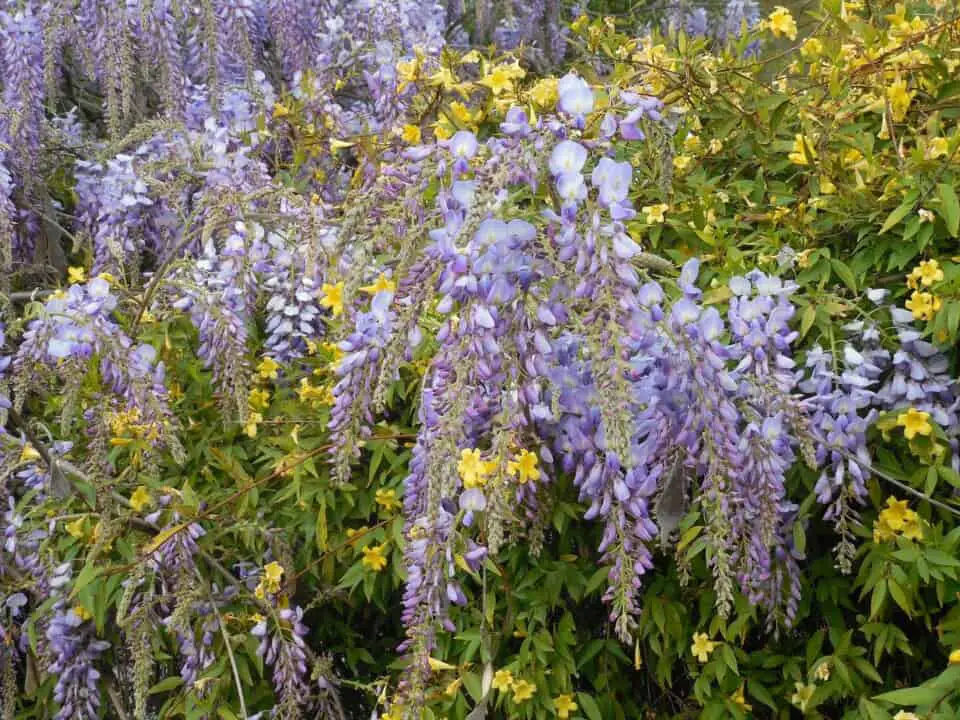Some links in the post are affiliate links and I get a commission from purchases made through some links found in the post.
If you’re reading this, you are probably wondering what you are doing wrong and why your plant’s leaves have turned yellow. I can understand where you might be coming from and what you might be feeling.
The first year after I planted my wisteria, I was eager for spring to start so I could enjoy seeing some of the wisteria’s foliage before its blooming years.
But alas! That was not to be – the leaves were yellow. I could not understand how new leaves could be yellow.
I knew that older leaves could yellow as they neared the end of their cycles but had not seen this in small leaves. So, I was sure that my plant had a problem.
But guess what? Yellowing in new leaves is normal in wisterias. As the leaves develop, they take on a yellow hue. However, as they grow bigger, they start turning green and eventually turn a deep green at maturity.
At the end of their cycle, the wisteria leaves start turning yellow and falling off. I should add that they fall off one by one as the cold weather starts setting in.
That means that yellowing in wisterias is normal. But this only extends to new leaves in the spring and older leaves in the fall. Does that describe your wisteria?
If yes, you have nothing to worry about. But if your wisteria leaves are turning yellow between the seasons and not in the manner I described above, other reasons are likely behind the change.
The main reason your wisteria will be turning yellow is due to overwatering and poor drainage.
Other than this pest infestations, an imbalance in soil nutrients and underwatering can all lead to your wisteria leaves turning yellow.
I will get into each of them and their solutions and detail what you can do to deal with the unsightly yellow leaves.
Are you ready?
Why Are Your Wisteria Leaves Turning Yellow?
When I deal with yellowing in plants, I often consider overwatering the biggest possible culprit.
In this case, I want to twist this approach by focusing on living and breathing causes of yellowing as my first pick. Can you guess where I’m headed?
Your Wisteria Is Infested by Pests
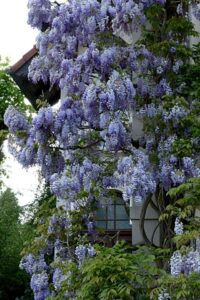 Wisterias are known for their hardiness. After all, they are woody and toxic to most animals. So, the thought of something feeding on your wisteria may seem off.
Wisterias are known for their hardiness. After all, they are woody and toxic to most animals. So, the thought of something feeding on your wisteria may seem off.
But it’s a probable cause behind the sudden change in wisteria hue. Some pests will eat almost anything and not shy away from feeding on the woody stems and branches in wisterias.
Is your wisteria infested by pests? Unlike some of the other yellowing causes, I will cover, pest infestations often exhibit a wide range of signs. You will notice that:
- Your wisteria is losing many leaves at once,
- Your wisteria is showing signs of discoloration, e.g., brown or black spots on its leaves,
- The plant appears droopy despite having adequate access to water,
- The plant shows holes on its leaves,
- The plant has stunted growth or does not grow at all, and
- The plant has yellowed or browning leaves.
Dealing with all these signs at once can leave you confused about what’s ailing your plant. Thus, it’s easy to miss the pest infestation as you might focus on other yellowing causes like underwatering.
But if you notice holes on the wisteria or missing leaves that you cannot find beside the plant, it’s always good to inspect the plant for:
Aphids
Almost every gardener has dealt with these pesky insects at some point. They attack plants by feeding on their juices, thus depriving the leaves of the ability to make food and robbing them of tissues.
The affected leaves start curling on the edges and losing their color. That’s when you start noticing fading and the leaves turning yellow on your wisteria.
But that’s not all that aphids do – they also leave secretions as they feed on the leaves. And these residues are ideal environments for fungal growth, encouraging the establishment of microorganisms that can further damage the plant.
How to Deal with Aphids
Getting rid of aphids is not as difficult as it may seem. You can bid them adieu by:
- Wiping them off with insecticidal soap: You can make this at home by mixing one part of warm water with another part of mild soap. Use this on the plant and wipe the affected parts.
- Pruning: If the infestation has spread far, it’s always best to prune the affected parts. It helps the plant focus more on foliage and bud production rather than healing the damaged parts.
- Applying neem oil on the plant: Neem oil is a known preventative method against pests, and it works great against aphids. Apply this to the plant to deal with the current infestation and keep possible pests at bay.
- Introducing natural predators to the garden: What better way to deal with aphids than using the natural order? Introduce insects like lacewings and ladybugs into the garden and allow them to deal with the aphids on your behalf.
Of course, the best approach would be to prevent the aphid invasion in the first place. And you can do this by providing the plant with adequate water, nutrients, and light.
You may also like: The common problems with a wisteria & how to fix them
Scales
Scales are quite dangerous because they are easy to undermine. After all, they are quite small, and one might think that their effect would also be as small.
However, these insects thrive on sucking the sap out of the wisteria, interrupting the natural flow of water and nutrients. As such, they disrupt photosynthesis and other crucial processes, weakening the plant.
Weak wisterias are a good breeding ground for disease-causing microorganisms. Add the fact that scales secrete honeydew as they feed on the sap.
Soon enough, fungi and other organisms start establishing on the plant. As time goes by, the leaves start yellowing and falling off.
Dealing with Scales
It’s best to deal with these infestations as soon as they occur by:
- Using homemade soap: You can deal with small infestations by spraying the plant with insecticidal soap,
- Strengthening the plant: A weakened wisteria is at more risk of infestation than a healthy one. It’s always good to ensure your plant has adequate access to water, light, and nutrients,
- Spraying the plant with neem oil: Horticultural oil is effective in preventing scale infestations, and
- Introducing natural predators like birds and wasps.
Controlling the infestation is always crucial in preventing further damage to the plant.
Borer Beetles
Borer infestations are no joke. These insects bore into the wisteria, injuring the plant tissue and creating a gateway for disease-causing microorganisms.
Over time, the wisteria becomes a habitat for microorganisms, and the plant starts rotting from the inside.
The more the borers and other pests attack the plant tissues, the harder it is for the wisteria to transport water and nutrients. And without these vital plant needs, the leaves of the wisteria start turning yellow as the plant slowly dies.
Dealing with Borers
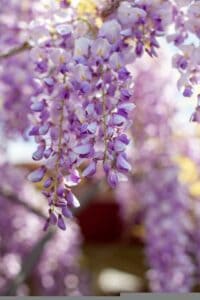 Like with aphids, the best approach would be to prevent an infestation. But because that might not always be feasible, you can deal with attacks by:
Like with aphids, the best approach would be to prevent an infestation. But because that might not always be feasible, you can deal with attacks by:
- Using insecticides on the plant: This method is most effective for dealing with larvae. As soon as they hatch, they ingest the chemicals and die.
- Pruning the affected plant parts: You can save your wisteria energy by pruning off the damaged parts. It enables the plant to focus its energy on healing.
Neem oil can also help you ward off pests. But in this case, it’s best to use chemical means before the beetles have their way and kill the wisteria.
Other wisteria pests include caterpillars, pigeons, carpenter bees, and mealy flats. On the upside, not many animals will feed on the wisteria because of its toxicity.
But that does not mean that some pesky insects or birds will not come along and try their luck. So, how can you keep your wisteria safe?
- Strengthen its immune system: Wisterias can withstand most infestations without dying if they are healthy enough. And the way to ensure this is to provide them with adequate water, light, and nutrients.
- Using neem oil on the plant to ward off pests.
Please note that not all pests are harmful to your wisteria. Some may actually be beneficial. So, as long as the plant looks healthy, there’s no reason to attack insects and birds you find on the plant.
You may also like: Wisteria vs lilac
Your Wisteria is Overwatered
Most yellowing issues often result from feeding the plant with too much water. The common notion behind wisterias is that they enjoy moist soil because they grow in wet areas.
And you are right to think that affording them a similar environment would work to their benefit. However, wisterias can only withstand moist soil to a given extent.
Beyond that, their roots start sitting in the water for prolonged periods and start drowning over time.
The roots lack oxygen and cannot facilitate the movement of water and nutrients to the plant. As a result, the wisteria grows weaker, hence the the leaves turning yellow.
But what causes overwatering?
- Giving the plant too much water: The wisteria needs an inch of water each week. So, if it has already rained, you do not need to water it more. But some people do, and this paves the way for waterlogging. Such conditions are ideal for the growth of fungi that attack the wisteria.
- Using poorly draining soil: Wisterias prefer rich and well-draining soil. If you use soil with a fine texture, it holds on to too much moisture. And that’s a recipe for waterlogging.
- Lack of adequate access to sunlight: Wisterias prefer being in the full sun. Under these conditions, they can make food using light and water. But when they are in shaded conditions, they cannot make much use of the water and end up sitting in it for too long.
Can you resonate with any of these causes?
Dealing with Overwatering
The good thing about overwatering is that it’s easy to avoid. How do you go about it?
- Only water the wisteria when it needs water: The wisteria needs an inch of water each week. In the colder months, this need reduces as the plant goes dormant and no longer needs as much moisture. As such, you should always check the top two inches of soil to gauge if the plant needs water. And if you are unsure of whether it needs water, you can always get a moisture meter. The readings are accurate and will help you avoid waterlogging issues.
- Ensure the plant has well-draining soil: Medium texture soil is always best for the wisteria as it balances drainage and retention rates. To achieve this texture in fine soil, you will need to add coarse-textured soil like sand to even out the texture.
- Clear the shade around the plant to allow it more access to the light. If this is not feasible, you can always invest in artificial light to account for the difference in light exposure.
The wisteria should recover once you have altered your watering schedule and followed through with the drainage and lighting checks.
What Should You Do with a Wisteria with Root Rot?
Root rot is every gardener’s nightmare, but that does not keep it from recurring. So, if this happens to be the case with your wisteria, you will notice signs like:
- Drooping/ wilting,
- Yellowing of the leaves,
- Fungal growth on the soil, and
- A foul smell from the soil.
Such signs indicate that the roots have suffered damage, and you must act fast to save the plant. How do you do it?
- You will need to uproot the plant and inspect just how extensive the root damage is: If it has affected more than 70% of the root system, you will likely need a new plant. But if the damage is less than this, the plant can still survive.
- You will need to cut off the damaged root parts (the soggy white parts), leave the root to dry, and then apply a fungicide to it.
- You can then prepare a new hole and fill it with rich and well-draining soil before transplanting the affected wisteria. Water it well and leave it to establish in its new environment.
Please note that wisterias do not like being transplanted, which should be the last resort. However, you do not have much of a choice with root rot as the odds are not in your favor.
In the days that follow the transplanting, the wisteria will show signs of drooping, which is expected.
You may also like: What fertilizer should you use for your wisteria
Your Wisteria is Underwatered
Wisterias do best in moist conditions and will not do well when left in dry soil for too long.
It is thus not a surprise to learn that the yellowing in your plant’s leaves could owe to a lack of adequate water.
An underwatered wisteria also shows signs of drooping. However, it has a clear tell in the form of curling and even drying of the leaves. What causes underwatering?
- A poor watering schedule where the plant goes without water for too long,
- A soil mix with a poor retention rate, and
- Exposure to high temperatures.
Sometimes, it is a combination of all three factors.
Dealing with Underwatered Wisterias
The good thing is that underwatering rarely kills wisterias. However, it can interfere with the blooming processes and weaken the plant’s immune system. To deal with it, you should:
- Implement a consistent watering schedule that changes with the seasons. Remember to water the plant more in the summer and cut back in the winter. Please note that overwatering is worse than underwatering. So, when in doubt, do not water the plant. Or use a moisture meter to be on the safe side.
- Add more compost to the soil mix to increase the water retention rate, and
- Add mulch around the plant’s base to help the plant hold on to more water.
If you live in a hot area, you will need to keep checking on the plant to ensure it does not end up dehydrated.
Can Yellow Wisteria Leaves Be Restored to Healthy Leaves?
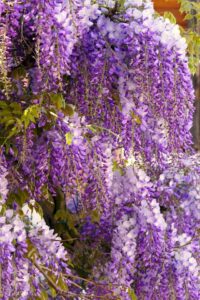 Now that you know what causes the leaves of your wisteria plant to be turning yellow, can you turn the leaves back to green? To understand whether this can happen, we must understand what lends leaves the yellow and green colors.
Now that you know what causes the leaves of your wisteria plant to be turning yellow, can you turn the leaves back to green? To understand whether this can happen, we must understand what lends leaves the yellow and green colors.
Chlorophyll makes leaves appear green and enables them to make food. But when a plant suffers problems like pest infestations and underwatering, it loses its chlorophyll.
The plant starts taking up what’s left in the damaged leaf, thus taking away its chances of survival. In most cases, this change in hue signifies the death of the leaf, and you cannot do anything about it.
Are there exceptions? Yes!
- New wisteria leaves: When the leaves of the wisteria are emerging, they appear small and yellowed. It’s part of the cycle, and they take on a green hue over time.
- Underfed wisteria leaves: In some cases, all your plant needs is a boost in nutrition, and its leaves start turning green again.
In both cases, you must be patient with the plant and allow the leaves to eventually take on a green hue.
You may also like: Wisteria tree vs vine
Should I Cut the Yellow Leaves Off My Wisteria?
When the wisteria starts developing new leaves, they appear yellow. And if you were to cut them off, you would cut off the plant’s avenue to make food. So, in this case, the answer would be no.
What about in other cases?
Aging leaves
As fall ends, the leaves will fall off one by one. Usually, you will have a few scattered yellow leaves on the plant. You can allow them to remain on the plant.
But if they bother you a lot, you can cut them off. Ensure you use sharp and sterilized tools to avoid injuring the plant and paving the way for disease-causing microorganisms.
Please note that pruning should only take place after blooming has ended.
Infested leaves
When dealing with widespread pest infestations, cutting off the damaged leaves is always a good move as it controls the extent of the infestation.
Follow through with pest control methods like neem oil application and wiping the plant with insecticidal soap.
Causes unrelated to aging and diseases
It’s always best to understand why your the leaves of your wisteria are turning yellow. Is it underwatered? Does it have root rot? Knowing the cause allows you to attack the culprit and prevent the yellowing of more leaves.
Otherwise, you keep pruning off the yellowing leaves season in and out, and the plant grows weaker. Once you have established the cause, focus on its remedy.
And if you still feel like cutting off the yellow leaves, please do so with clean tools and after blooming has ended.
If you prune your plant, do not cut back on more than 50% of the plant, which can hurt its blooming chances.
You may also like: 6 great benefits of owning a wisteria
Why Are My Wisteria Leaves Turning Brown?
Besides yellowing leaves, you may also deal with browning wisteria leaves at some point. Below are some of the causes of such hue changes and what you can do about it.
1) Overwatering and Root Rot
You must ensure that your plant gets enough water without drowning its roots. The best way to do this is to implement a sound watering schedule, ensure the soil is well-draining, and give the plant adequate access to light.
2) Transplant Shock
Wisterias do not like being moved to new locations. In most cases, they react by drooping, and you may even notice browning in their leaves.
The best approach to this is to avoid moving the plant as much as possible. But if you must, ensure that it gets enough nutrients, light, and water. And be patient with it as it acclimates to its new home.
3) Pest Infestations
Pest attacks can result in leaf discoloration. Understand the pest behind the color change and deal with it using the most effective means, as discussed under pest infestations earlier.
4) Too Much Sun Exposure
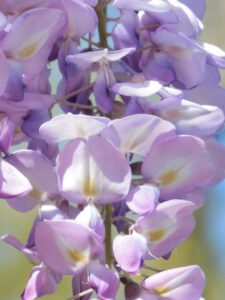 Wisterias do well in USDA zones 9 and below. If you plant them in hot regions, you may notice that their leaves start taking on a brown hue, resulting from foliage damage.
Wisterias do well in USDA zones 9 and below. If you plant them in hot regions, you may notice that their leaves start taking on a brown hue, resulting from foliage damage.
However, this often happens when the plant is not getting enough water. If underwatering has not contributed to the hue change, consider shading the plant with a cloth or a suitable alternative.
Are any of these issues to blame?
Final Thoughts
Wisterias will rarely give you trouble. But if they do, you are likely depriving them of an essential need. And once you figure out what it is and fix it, the plant will bounce back to its usual healthy state.
Happy Gardening!

